Red (game)
| Red レッド Red | |
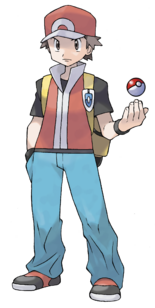 Art from FireRed and LeafGreen | |
| Age | 11RBYFRLG 14GSCHGSS 16+B2W2 |
|---|---|
| Gender | Male |
| Hometown | Pallet Town |
| Region | Kanto |
| Relatives | Mother |
| Trainer class | Player character, ChampionRBYFRLG Pokémon TrainerRBYFRLGGSCHGSSB2W2 |
| Generation | I, II, III, IV, V |
| Games | Red, Green, Blue & Yellow Gold, Silver & Crystal FireRed, LeafGreen HeartGold, SoulSilver Black 2 and White 2 Pokémon Stadium, Stadium 2 |
| Champion of | Indigo Plateau |
| Game animation debut | Pokémon Origins |
| English voice actor | Bryce Papenbrook |
| Japanese voice actor | Junko Takeuchi |
| Anime counterpart | Ash Ketchum, Red |
| Counterpart debut | Pokémon - I Choose You! |
| Manga counterpart(s) | Red, Red, Red, Red, Ash Ketchum, Satoshi, Shū |
Red (Japanese: レッド Red) is the canon name of the player character in the Generation I games Pokémon Red, Green, Blue, and Yellow and the male choice in their Generation III remakes Pokémon FireRed and LeafGreen, where his female counterpart is Leaf.
Red is known throughout as the Champion from Pallet Town, as well as the living legend for his defeat of Team Rocket in Kanto during his quest. He is the final opponent in the Generation II games Pokémon Gold, Silver, and Crystal, their Generation IV remakes Pokémon HeartGold and SoulSilver, and Pokémon Stadium 2. He is also a participant in the Pokémon World Tournament's Champions Tournament in Pokémon Black 2 and White 2.
In the games
Red is introduced as a curious 11-year-old boy from Pallet Town. In the instruction manuals of Pokémon Red, Green, and Blue Versions, Red gained an interest in Pokémon after his best friend, Blue, stopped playing with him and became a bully. His adventure begins one day when Professor Oak calls the two to his lab for a starter Pokémon. Oak intends to give Red an Eevee, but Blue takes it. Red is forced to start with a Pikachu that Oak caught on Route 1 earlier. The Pikachu refuses to stay in its Poké Ball and insists on following Red around. Blue challenges Red to a battle immediately, to test out his new Pokémon, thinking he will easily beat Red.
After Red has made his way to Viridian City to the north and taken a package back to Oak in Pallet Town, Oak gives Red and Blue each a Pokédex with which to record data on all known Pokémon in the Kanto region to fulfill Oak's dream of creating a full guide on all Pokémon in Kanto. From here, Red and Blue journey across Kanto, collecting Pokémon to build up their teams, and defeating each of the Gym Leaders in turn, with Blue always one step ahead, showing up from time to time to impede Red's progress.
Red also comes across a gang of Pokémon thieves, Team Rocket, several times through his journey, defeating a group of Team Rocket Grunts and Team Rocket Trio of Team Rocket agents named Jessie and James, all of who are trying to steal Fossils from Mt. Moon; a member who is running the Nugget Bridge challenge to recruit for the organization on Route 24; and another lone member who has stolen a TM from a family in Cerulean City. Eventually, Red uncovers a plot by Team Rocket, infiltrating their hideout beneath the Celadon Game Corner and encountering their boss, Giovanni. Defeating him and ousting Team Rocket from Celadon, Red uses the Silph Scope that Giovanni leaves behind to battle Ghost-type Pokémon and save Mr. Fuji in the Pokémon Tower in Lavender Town, who is being held hostage by Jessie and James. Red soon journeys into Saffron City in the heart of Kanto to find it overrun by Team Rocket, who is attempting to take the recently-invented Master Ball from the Silph Co. President, and defeats Giovanni again, ending the group's plots for the time being.
With seven Badges in hand, Red encounters Giovanni for the final time—this time as the Leader of the Viridian Gym, his final obstacle before the Elite Four of Indigo Plateau. Red defeats him in battle, earning his eighth and final Badge—the Earth Badge—and causing Giovanni to realize that Pokémon battles are about having fun, not business. He disbands Team Rocket, promising to go into solo training to become a better Trainer.
Making it through Victory Road and finally to Indigo Plateau, Red challenges the Indigo League. First, he defeats the Elite Four and discovers, to his surprise, that Blue has defeated them before him and is therefore the Champion of Kanto. Red defeats Blue in the final battle, becoming the Champion himself, but then continues his training, rather than staying at Indigo Plateau. Encountering an offshoot of Team Rocket in the southern Sevii Islands, lead by Executive Archer, Red reveals with his Earth Badge that Giovanni has disbanded the organization, and, though defeated, the group there intends to revive Team Rocket and bring Giovanni back, having already made plans to force Pokémon to evolve with radio waves.
After returning to Kanto from the Sevii Islands, Red catches the Legendary birds: Articuno, Zapdos, and Moltres. He learns of Mewtwo, the only Kanto Pokémon he has not caught. Red makes his way to Cerulean Cave, where he finds and catches Mewtwo. With that, Red has completed the Kanto Pokédex.
Red continues as a wandering Trainer, eventually making his way to the caves of Mt. Silver, where he trains his Pokémon alone.
Eventually, Ethan, Kris, or Lyra arrives at Mt. Silver and challenges Red, identified only as a Pokémon Trainer. If defeated, Red vanishes from Mt. Silver, and returns every time the Elite Four is defeated again by the player of Gold, Silver, Crystal, HeartGold, or SoulSilver.
Some time later, Red enters the Champions Tournament of the Pokémon World Tournament in the Unova region.
Pokémon
As the player character, Red can have on his team any of the 151 Pokémon available during Generation I. In Generation III, he can have any of the 386 Pokémon available at that time, though only after the player has obtained the National Pokédex.
When he is encountered as an opponent in Generation II and Generation IV, Red has a set team, based on Generation I in-game event Pokémon, and has the highest leveled trained Pokémon yet encountered in the series, with his Pikachu at level 81 in Generation II and at level 88 in Generation IV.
In Pokémon Black 2 and White 2, he can be fought in the Pokémon World Tournament's Champions Tournament, using the same team he did in Generation IV, albeit with different movesets.
Pokémon Gold, Silver, and Crystal
|
|||||||||||||||||||||||||||||||||||||||||||||||||||||||||||||||||||||||||||||||||||||||||||||||||||||||||||||||||||||||||||||||||||||||||||||||
| |||||||||||||||||||||||||||||||||||||||||||||||||||||||||||||||||||||||||||||||||||||||||||||||||||||||||||||||||||||||||||||||||||||||||||||||
Pokémon HeartGold and SoulSilver
Pokémon Black 2 and White 2
Red uses three of these Pokémon in Single Battles, four in Double and Rotation Battles, and all six in Triple Battles.
|
|||||||||||||||||||||||||||||||||||||||||||||||||||||||||||||||||||||||||||||||||||||||||||||||||||||||||||||||||||||||||||||||||||||||||||||||||||||||||||||||||||||||||||||||||||||||||||||||||||||||||||||
| |||||||||||||||||||||||||||||||||||||||||||||||||||||||||||||||||||||||||||||||||||||||||||||||||||||||||||||||||||||||||||||||||||||||||||||||||||||||||||||||||||||||||||||||||||||||||||||||||||||||||||||
Pokémon Stadium 2
Round 1
|
|||||||||||||||||||||||||||||||||||||||||||||||||||||||||||||||||||||||||||||||||||||||||||||||||||||||||||||||||||||||||||||||||||||||||||||
| |||||||||||||||||||||||||||||||||||||||||||||||||||||||||||||||||||||||||||||||||||||||||||||||||||||||||||||||||||||||||||||||||||||||||||||
Round 2
|
|||||||||||||||||||||||||||||||||||||||||||||||||||||||||||||||||||||||||||||||||||||||||||||||||||||||||||||||||||||||||||||||||||||||||||||
| |||||||||||||||||||||||||||||||||||||||||||||||||||||||||||||||||||||||||||||||||||||||||||||||||||||||||||||||||||||||||||||||||||||||||||||
Quotes
Red is portrayed as a silent character, and apart from exclamation points and question marks, his NPC speech consists entirely of ellipses.
Artwork
| File:Sugimori Starter artwork.png | 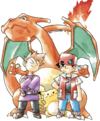
|
File:Rival artwork.png | 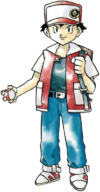
|
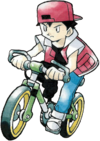
|
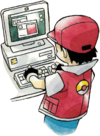
|

| |
| Early artwork | Starter artwork with Blue and Leaf |
Early artwork with Blue, Charizard, and Pikachu |
Early artwork battling Blue | Official art of Red from Generation I |
Riding his Bike | Checking the PC |
In warm clothing, holding a shovel |
Sprites
| Sprite from Red, Green, and Blue |
Title screen sprite from Red, Blue, and JP Blue |
Title screen sprite from Red and Green |
Sprite from Yellow |
Sprite from Generation II |
Sprite from FireRed and LeafGreen |
| Intro sprite from FireRed and LeafGreen |
Sprite from HeartGold and SoulSilver |
Sprite from Black 2 and White 2 |
Backsprite from Red, Green, and Blue |
Backsprite from Yellow |
Backsprite from FireRed and LeafGreen |
| Overworld sprite from Generation I |
Overworld sprite from Generation II |
Overworld sprite from FireRed and LeafGreen |
Overworld sprite from Emerald |
Overworld sprite from HeartGold and SoulSilver |
Overworld sprite from Black 2 and White 2 |
| Portrait from Stadium 2 |
Credits sprite from FireRed and LeafGreen |
Model from Colosseum |
Headshot from Gale of Darkness |
Optional names
| Game | Japanese | English | French | German | Italian | Spanish |
|---|---|---|---|---|---|---|
| Red | レッド Red サトシ Satoshi ジャック Jack |
Red Ash Jack |
Red Sacha Paul |
Rot Ash Jack |
Rosso Ash Gigi |
Rojo Ash Jaime |
| Green | グリーン Green シゲル Shigeru ジョン John |
|||||
| Blue | ブルー Blue ツネカズ Tsunekaz ジャン Jean |
Blue Gary John |
Bleu Régis Jean |
Blau Gary John |
Blu Gary Pippo |
Azul Gary Juan |
| Yellow | イエロー Yellow サトシ Satoshi ジャック Jack |
Yellow Ash Jack |
Yellow Sacha Paul |
Gelb Ash Jack |
Giallo Ash Gigi |
Gualdo Ash Jaime |
| FireRed LeafGreen |
ファイア Fire レッド Red リーフ Leaf グリーン Green カモン Kamon ケイ Kei ケン Ken サトシ Satoshi サトル Satoru シゲキ Shigeki シゲル Shigeru ジャック Jack ジャン Jean ジョン John タカオ Takao タカシ Takashi タケヒロ Takehiro ツネカズ Tsunekaz テツオ Tetsuo トオル Tōru ヒトシ Hitoshi ヒロアキ Hiroaki ヒロキ Hiroki マサオ Masao |
Red Fire Green Leaf Ash Gary Geki Hiro Jak Janne Jon Jonn Kamon Karl Kay Kaz Kene Max Oscar Ralph Roak Toru Taylor Tosh |
Red Fire Green Leaf Ayrton Damien Davy Franck Greg Kamel Loris Mael Mario Max Polo Ralph Tom Tosh Vince Yan Zack |
Rot Feuer Grün Blatt Bert Chris Daniel Gerd Hans Helge Jack Jan John Jon Ralf Rolf Sven Tobi Udo Uli Uwe |
Joro Guefo Verte Jaho Álvaro Bosco Candel Floren Furio Juan Juanma Juno Lerio Llamín Marino Max Morel Ner Rafa Ral Rodi Silvio Toilo Ver |
In the Super Smash Bros. series

Super Smash Bros. Melee
Red's hat appears in Super Smash Bros. Melee as an alternate outfit worn by Pikachu, possibly in reference to the anime or Pokémon Adventures.
Super Smash Bros. Brawl
- Main article: Pokémon Trainer (Super Smash Bros.)
Red himself appears as a playable character in Super Smash Bros. Brawl, named only as "Pokémon Trainer", with a team consisting of Squirtle, Ivysaur, and Charizard. Rather than fighting himself, like the other human characters, Red sends his three Pokémon into battle, switching between them in order. He is voiced by Michele Knotz in the English version and 半場友恵 Tomoe Hanba in the Japanese version.
In other games
Red makes an appearance in both Pokémon Colosseum and Pokémon XD: Gale of Darkness. While he does not appear in the games' Story Mode, he is playable in the Battle Mode when a FireRed or LeafGreen cartridge is used, with a male player character chosen. He can take on the Mt. Battle's 100-battle challenge, as well as compete in Colosseum battles. Red also made a brief appearance in the debut trailer of Pokémon Battle Revolution, having a Double Battle against Leaf, using a Deoxys in its Attack Forme and a Wailord. Despite this, he didn't appear in the final cut of the game.
In the TFG
Red appears as a common Trainer figure in the launch set, Next Quest, of the Pokémon Trading Figure Game. A recolour of the original figure named Green, aptly coloured with green clothes, appears as a Trainer figure in the Groundbreakers expansion.
Counterparts
In the anime
- Main article: Ash Ketchum
- Main article: Red (Origins)
Red's anime counterpart, introduced in the first episode, is the anime's main character, Ash Ketchum. Like Red, Ash is from Pallet Town, on a journey to become a Pokémon Master. Unlike Red, Ash's journey did not end with Kanto, and Ash has continued through every other region introduced in the main series games, as well as the Orange Archipelago south of Kanto, taking the place of the player characters of Generation II during Johto, and being joined by the anime counterparts of May and Dawn during the Hoenn and Sinnoh sagas. Instead of starting with one of the standard three Kanto starters, however, Ash began his journey with a Pikachu, inspiring Pokémon Yellow's creation, as well as causing some to consider Red and Ash to be exactly the same person, most especially due to Red owning one as well.
Red also had a direct counterpart that appeared as the main character of the Pokémon Origins mini-series, which takes place in a separate continuity. This counterpart shared both Red's name and FireRed and LeafGreen design.
In the manga
In the Pocket Monsters HGSS Jou's Big Adventure manga
Another counterpart of Red makes an appearance in Pocket Monsters HGSS Jou's Big Adventure. He was first mentioned by Blue while Jou battled the Gym Leader. Jou then officially encountered Red while on Mt. Silver.
Pokémon
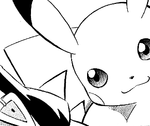 Pikachu |
In other manga
Red, like most player characters, also has several counterparts in the various Pokémon manga series.
In The Electric Tale of Pikachu manga
- Main article: Ash Ketchum (EToP)
Red's anime counterpart, Ash Ketchum, appears in The Electric Tale of Pikachu manga.
In the Pokémon Adventures manga
- Main article: Red (Adventures)
Red is Red's direct counterpart in Pokémon Adventures.
In the Pokémon Gotta Catch 'Em All manga
- Main article: Shū
Shū from Pokémon Gotta Catch 'Em All is based on Red.
In the Pokémon Pocket Monsters manga
- Main article: Red (Pocket Monsters)
Red shares his game counterpart's name and appearance in Pokémon Pocket Monsters.
In the Pokémon Zensho manga
- Main article: Satoshi (Zensho)
Satoshi from Pokémon Zensho is based on Red.
Trivia
- In the 1997 "Pocket Monsters Official Fan Book," Game Freak teased the supposed appearances of Red, Professor Oak, and Giovanni in the upcoming Pokémon Gold and Silver games. They called Red "Satoshi", the Japanese name of his anime counterpart Ash, which is also the namesake of the creator of the franchise and one of his default names, indicating that this is what they originally intended to call him before settling on the name "Red", one of the two original color versions of the games.
- Red's title screen and profile front sprites from Pokémon Red and Green correspond to his earlier Capsule Monsters artwork instead of his final Generation I artwork, suggesting that the sprites were created very early in the games' development or that Game Freak forgot to update their aesthetics to match the changes. His title screen sprite was updated in Pokémon Blue but the profile front sprite remained unchanged.
- In Pokémon Yellow, due to the completely distinct title screen, Red no longer has a title screen sprite. Although part of the changes made in Pokémon Yellow are directly inspired by the anime, the updates to Red's front sprite seem to be a mix of both matching his then official artwork more accurately and matching Ash Ketchum, his anime counterpart, as the frontal section of his cap has the same division in the middle as Ash's cap from the original series. This updated front sprite was then recycled for the Generation II games. Another possibility is that Pokémon Yellow actually uses the sprite from Pokémon Gold and Silver as these games were in development at least a year prior to the release of Pokémon Yellow in Japan. A similar situation occurs with Blue.
- Red's party in the Generation II games and Pokémon HeartGold and SoulSilver is based heavily on in-game events from the Generation I games and Pokémon FireRed and LeafGreen:
- Charizard, Venusaur, Blastoise, and Pikachu are the version mascots of the four Generation I games: Pokémon Red, Green, Blue, and Yellow. They are also available in all iterations of the original Kanto plot;
- Espeon could have been obtained as an Eevee in Celadon City, and Eevee notably serves as Blue's starter in Pokémon Yellow;
- Lapras is given away by a Silph Co. employee shortly before Team Rocket is defeated there;
- Two Snorlax are required to be caught or defeated in order to travel to Fuchsia City. Furthermore, in the Generation II games and Pokémon HeartGold and SoulSilver, only the Snorlax that was previously blocking Route 12 (now blocking the entrance to Diglett's Cave) is available to the player, suggesting that Red defeated it and caught the one blocking Route 16.
- All of these Pokémon are also obtainable within Pokémon Yellow: Pikachu is obtained as the starter Pokémon; Venusaur can be evolved from the Bulbasaur obtained in Cerulean City; Blastoise can evolved from the Squirtle obtained in Vermilion City; Charizard can be evolved from the Charmander obtained on Route 24; Snorlax, Eevee, and Lapras can be obtained by the aforementioned in-game events.
- In Pokémon HeartGold and SoulSilver, the four version mascots all know their Generation III signature moves: Venusaur, Charizard, and Blastoise know Frenzy Plant, Blast Burn and Hydro Cannon, respectively, while Pikachu knows Volt Tackle. Furthermore, his Pikachu's moveset coincides with the four moves that Ash's Pikachu used during the Diamond and Pearl series of the anime: Volt Tackle, Quick Attack, Iron Tail, and Thunderbolt.
- His party in the Generation II games also matches that of Red in the Pokémon Adventures manga during his venture to Mt. Silver, although Pokémon Adventures Red only borrowed Charizard and Blastoise temporarily from Blue and Green, respectively, as he didn't own those Pokémon.
- In Pokémon HeartGold and SoulSilver, apart from his Venusaur and Blastoise being fully evolved, Red's team is identical to that of Ash Ketchum throughout most of the Orange Islands anime arc (Ash's Bulbasaur and Squirtle were at the time, and still are presently, in their base forms).
- Until the release of Pokémon Platinum, Red's party in Generation II featured the highest-leveled opponent Pokémon a player could face outside of battle arenas such as the Pokémon Stadium series and the Battle Frontier, with his Pikachu at level 81, beating the wild Arceus found at the Hall of Origin by one level. In Pokémon Platinum, Barry's party received a boost in level, putting his starter Pokémon at level 85, while wild Magikarp can be found in the Resort Area at levels as high as 100, the maximum possible. Due to Pokémon HeartGold and SoulSilver giving Red's party a level boost as well, with his Pikachu topping at level 88, Red recovered his status as the highest-leveled Trainer opponent. Benga on Challenge Mode however is a close second with a Level 85 on all 3 of his Pokemon. His levels are tied with Barry's on the weekend battles after beating the Champion 30 times.
- When Red is encountered at the summit of Mt. Silver during Generation II and Pokémon HeartGold and SoulSilver, he has no speech, merely repeating sets of ellipses before beginning the battle. This is a reference to his silent role in Generation I, as he only answered choice questions like Yes or No. This unique characteristic remains in later generations, especially in the remakes.
- In Pokémon FireRed and LeafGreen, Blue sarcastically calls him a "chatty gossip".
- Despite the ellipses before the battle, when talking to Copycat in Generation I and Pokémon FireRed and LeafGreen, the dialogue is the following:
{Player}: Hello, do you like Pokémon?
{Player}: Uh no, I just asked you.
{Player}: Huh? You're strange!
Copycat: Hmm? Quit mimicking? But, that's my favorite hobby!
{Player}: Hi, thanks for TM31!
{Player}: Pardon?
{Player}: Is it that fun to mimic my every move?
Copycat: You bet! It's a scream!
- This implies that Red is speaking, although it could be that Copycat has nothing to mimic, so she is making up words.
- Hidden data in the Generation I games reveals placeholder names for Red and Blue:
- The unused default name for Red in the English Generation I games is Ninten while Blue's is Sony. While it is impossible to view these names during regular gameplay, changing a few memory addresses in RAM can allow for these names to appear as shown here. This references the fact that in the years surrounding the releases of the Generation I games, Sony was Nintendo's main competition. Ninten is also the default name of the main protagonist of Mother, a game developed by Creatures, Inc. and which has worked on the Pokémon games since the start.
- In the Japanese Generation I games, the unused default names for Red and Blue differ between Pokémon Red and Green and Pokémon Blue and then between the latter and Pokémon Yellow[1]:
- In Pokémon Red and Green, Red's unused default name is やまぐち Yamaguchi while Blue's is いしはら Ishihara. Yamaguchi refers to Wataru Yamaguchi, an art director that worked on the original games, while Ishihara refers to Tsunekaz Ishihara, the current president and CEO of The Pokémon Company and who was the games' producer at the time.
- In Pokémon Blue, the unused default names for Red and Blue are, respectively, ゲーフリ Gēfuri, an abbreviation of Game Freak's name in Japanese (ゲームフリーク Gēmu Furīku), and クリチャ Kuricha, a reference to Creatures, Inc.
- In Pokémon Yellow, Blue's unused default name remained unaltered while Red's was subtly altered by gaining an extra digit (ゲーフリ1).
- Much like there is minimal information on his anime counterpart's father, Red's father is mentioned only briefly when examining a SNES at the Celadon Department Store in the Generation I games and Pokémon FireRed and LeafGreen.
- In Pokémon HeartGold and SoulSilver, Red is the only Trainer who uses the battle transition effect from Generation II.
- All of his anime and manga counterparts also own a Pikachu, excluding Satoshi from Pokémon Zensho who evolved his into a Raichu.
- Along with Blue, Lance, and the Generation I and III Kanto Gym Leaders (excluding Koga and Giovanni), Red has appeared in every generation of Pokémon games so far. He is also the only protagonist with this feat.
- Red is the only Champion to not appear at the lobby if defeated in the Champions Tournament of the Pokémon World Tournament in Pokémon Black 2 and White 2.
In other languages
| |||||||||||||||||||||
References
| Non-player characters in the core series games | ||||||||||||||||||||||||||||||
|---|---|---|---|---|---|---|---|---|---|---|---|---|---|---|---|---|---|---|---|---|---|---|---|---|---|---|---|---|---|---|
| ||||||||||||||||||||||||||||||
| Player characters | ||||||
|---|---|---|---|---|---|---|
| ||||||
| Pokémon Champions | |
|---|---|
| Core series | Blue • Lance • Red • Steven • Wallace • Cynthia • Alder • Iris • Diantha • Trace • Leon • Mustard • Peony • Nemona • Geeta • Kieran • Drayton • Most player characters |
| Masters EX | Blue • Lance • Red • Steven • Cynthia • Alder • Iris • Diantha • Leon • Scottie • Bettie • Ash • Nemona • Geeta • Calem • Serena • Hop • Marnie • Bede • Leaf • Nate • Rosa • Silver • Cheren • Bianca |
| Other spin-offs |
Ronald (TCG GB) • Mark (TCG GB) • Mint (TCG GB) • Glenn (Pokkén) • Master Rosé (Duel) |
| Animated series | Lance • Cynthia • Wallace • Alder • Diantha • Steven • Ash Ketchum • Leon • Iris • Nemona • Geeta |
| Other animation | Blue (Origins) • Red (Origins) • Calem (Generations) • Celestine (PttP) • Edgar Troy (PttP) • Ava (PttP) |
| Adventures | Professor Oak • Red • Sidney • Phoebe • Glacia • Drake • Steven • Wallace • Cynthia • Alder • Iris • Diantha • Leon • Mustard • Peony • Nemona |
| Other manga | Shigeru (Zensho) • Satoshi (Zensho) • Rald (Battle Frontier) |
| |||||||||||||||||||||||||

|
This game character article is part of Project CharacterDex, a Bulbapedia project that aims to write comprehensive articles on each character found in the Pokémon games. |
- Characters
- Characters with confirmed ages
- Male characters
- Pages with broken file links
- Game characters
- Playable characters
- Champions
- Red, Blue and Yellow characters
- Gold, Silver and Crystal characters
- FireRed and LeafGreen characters
- HeartGold and SoulSilver characters
- Stadium 2 characters
- Black 2 and White 2 characters
- Manga characters















































